Ap Art History Dome of the Rock Form Function Content Context
West Asia
Petra
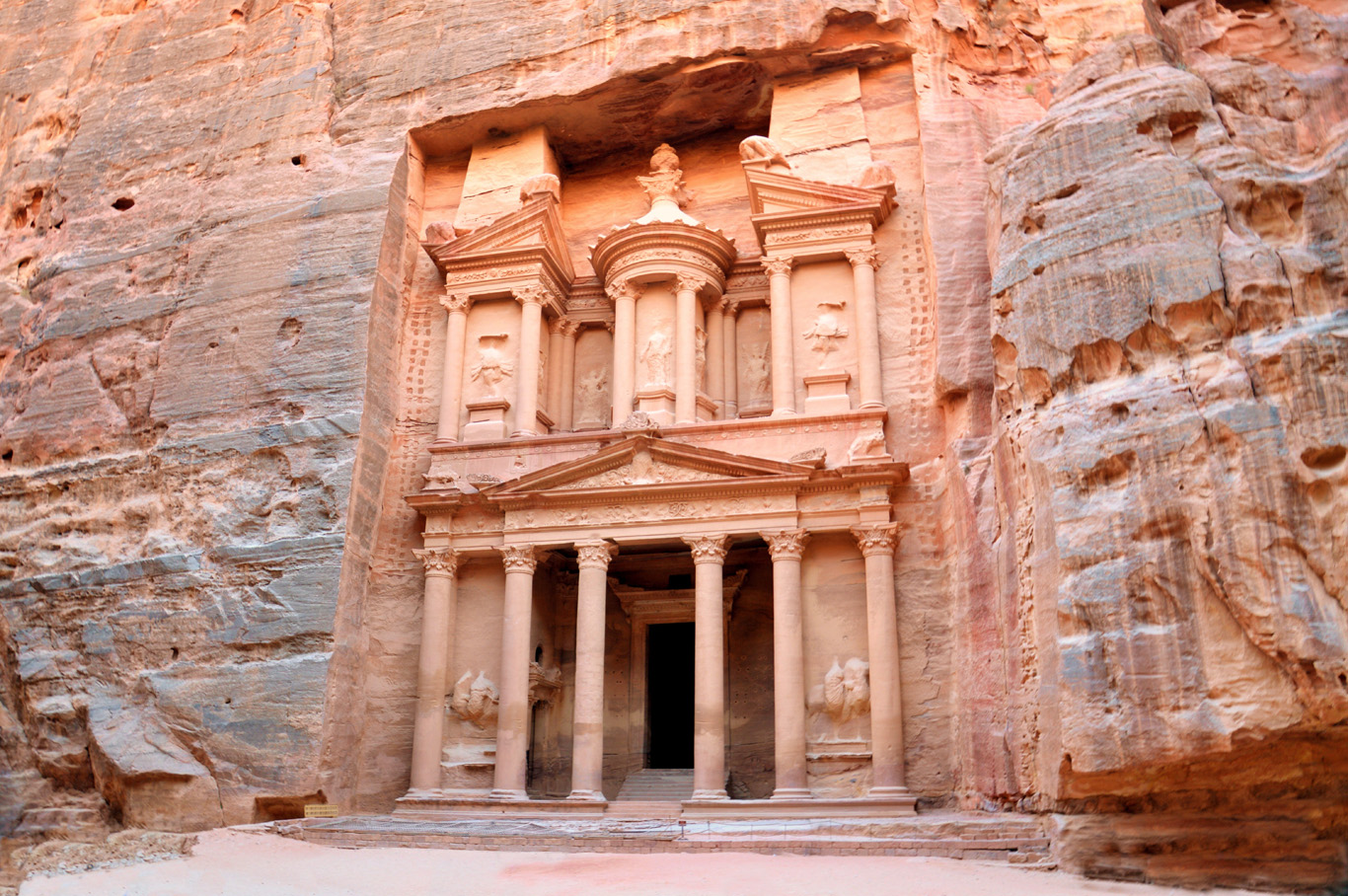
Image Courtesy of Take a chance Travel. The Treasury of Petra.
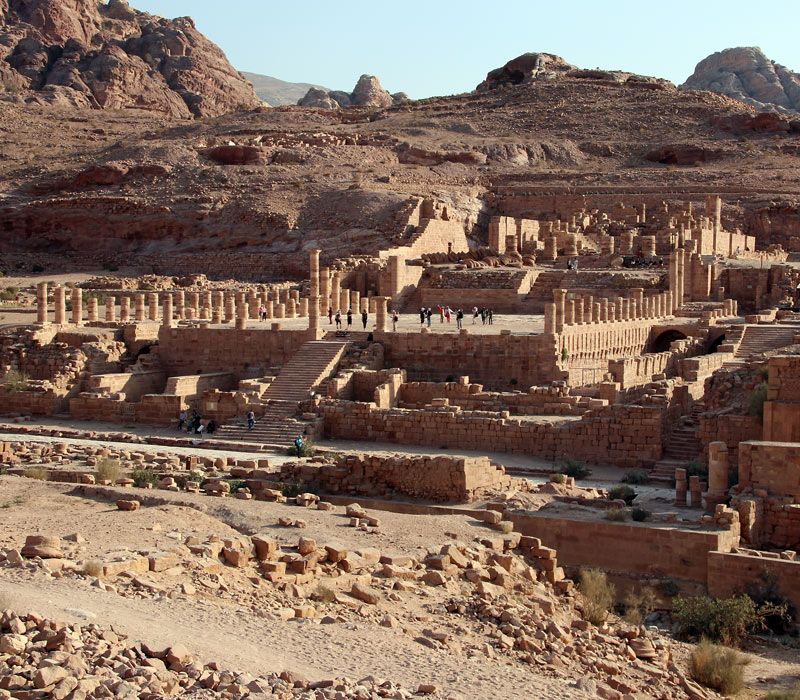
Prototype Courtesy of Universes in Universe. The Cracking Temple of Petra.
Class
-
Cut rock
-
The style of architecture was influenced by Greece and Alexandria, every bit evidenced past the employ of Corinthian columns (columns with leaves 🍃 carved near the capitals) and pediments (a triangular 🔺 meridian nigh the front end of a building).
Function
-
Petra was a trading city located in nowadays-twenty-four hours Jordan, which was and then a part of the Nabataean Kingdom.
Content
-
In the cliffs ⛰️ are tombs, where the Nabataeans buried the dead.
-
On the façade of Petra's treasury are carvings of Greek, Egyptian, and Assyrian gods, showing the region's exposure to different religions from nearby empires and the combination of indigenous and nonnative traditions.
Context
-
Finding out when the tombs of Petra were built has been difficult for archaeologists to figure out 🤷♂️, so they presume that they were created when the Nabataeans were richest, which is between the 2nd century BCE and second century CE.
The Kaaba
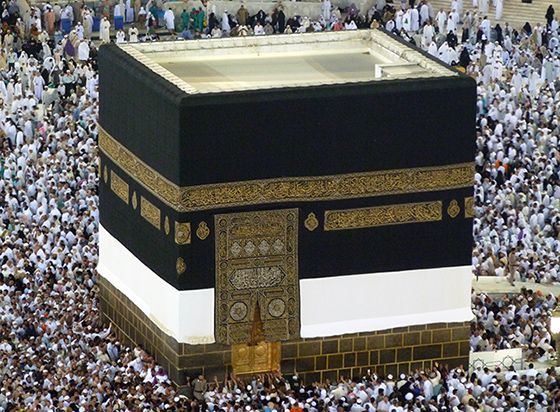
Image Courtesy of Khan Academy.
Form
-
Blackness granite covered in silk, gold, and silver
Part
-
Muslims around the world pray 5 times each day in the direction of the Kaaba in Mecca, Kingdom of saudi arabia from where they currently are (qibla).
-
Muslims are expected to make the Hajj (pilgrimage to Mecca) one time in their lifetime, and during this trip, they circumambulate (go around) the Kaaba counterclockwise 🔄 seven times.
Content
-
Roofing the Kaaba is a layer of black cloth (the kiswah), which is covered with ornate calligraphy (decorative handwriting).
-
The Kaaba has been repaired and reconstructed 🚧 many times since the time of Muhammad (the founder of Islam).
Context
-
This building is said to take been built by Ibrahim (Abraham) and his son Ishmael.
Dome of the Rock
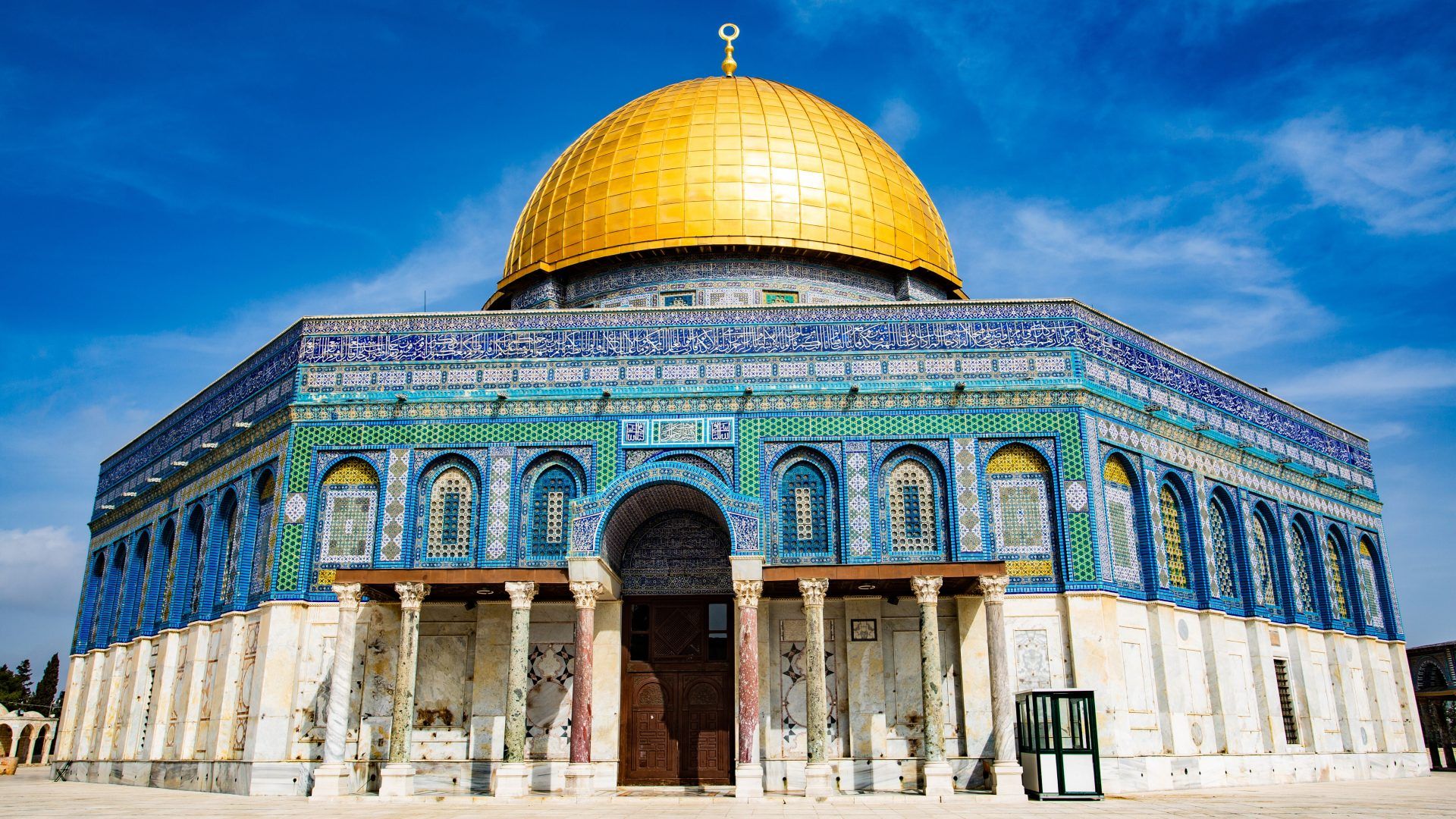
Image Courtesy of Tourist Israel
Grade
-
Rock and woods octagon busy with ceramic and mosaics
Function
-
Nigh people believe that the Dome of the Stone was originally built to commemorate where Muhammad ascended to Sky (miʿraj), but it is besides the identify where Abraham virtually sacrificed Isaac and the Temple of Jerusalem once stood.
Content
-
The building is covered in Arabic calligraphy.
-
The designs roofing the Dome of the Rock are geometric (made with lines and elementary shapes) and do non contain whatever human 👩 or beast 🐪 forms.
Context
-
The Dome of the Rock is a pregnant landmark in the Abrahamic religions (Christianity, Judaism, and Islam).
-
Some believe that Abd al-Malik constructed the building so that more people would visit it, rather than making the Hajj to Mecca. His enemy Abd Allah ibn al-Zubayr, who lived in Mecca, was successful at getting visitors to the holy city, and al-Malik wanted to limit his success (talk well-nigh tea ☕).
Slap-up Mosque (Masjid-e Jameh)
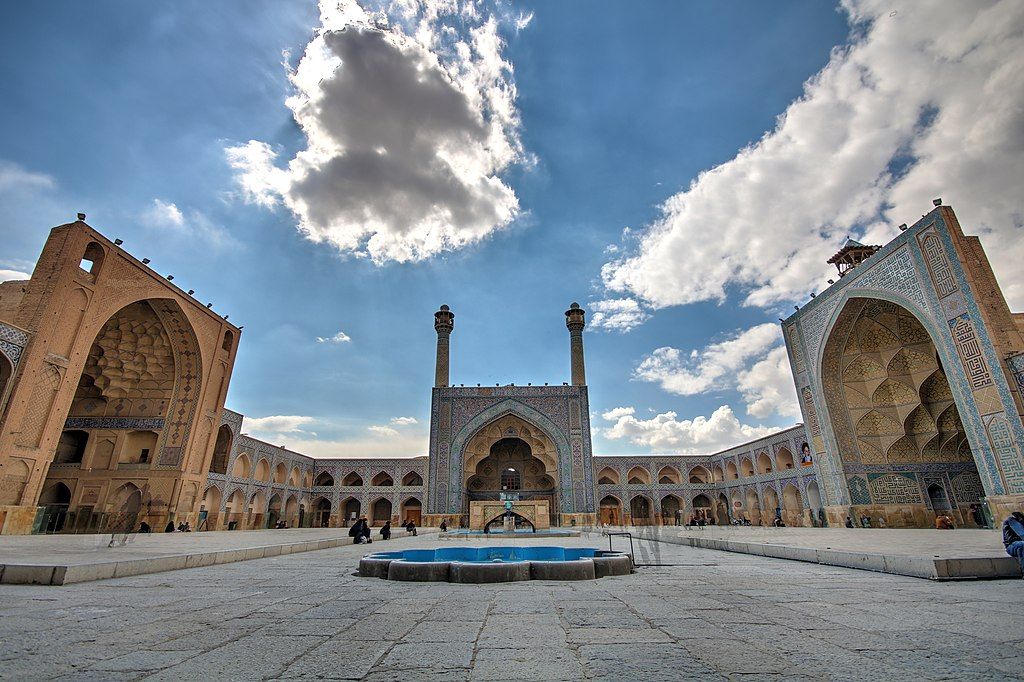
Image Courtesy of reibai (CC BY 2.0)
Grade
-
Brick, plaster, wood, and ceramic tile
-
At the center of the building is a rectangular courtyard, which is surrounded by a two-story arcade (a structure made of arches supported by columns) and an iwan (a rectangular vaulted space that is closed on three sides and open on 1) at each side.
Office
-
The purpose of a mosque is to unite the umma (Muslim customs) through faith ☪️
-
Because of the Bang-up Mosque's location in the center of Isfahan, this mosque also functioned equally a place for gathering.
Content
-
The muezzin (person who leads prayer) goes onto the minarets (thin, portruding columns) five times each 24-hour interval to call people to prayer.
-
Calligraphy 🖊️, tilework, brick, and stucco motifs add ornament to the mosque.
-
The inside of the mosque is a hypostyle hall (a identify with a roof that is supported by columns), similar to the Temple of Amun-Re and Hypostyle Hall from unit 2.
Context
-
Considering the mosque has existed under so many different empires and dynasties, including the Il-Khanate, Timurid, Safavid, and Qajar, each group has contributed its own manner to the original edifice.
Folio from a Qur'an

Image Courtesy of Khan Academy
Course
-
Ink and gilded on parchment (a writing surface made from animal skins).
Function
-
Considering this piece of work is so heavily busy with an expensive cloth similar gold, it can causeless that it was used for ceremonial purposes, rather than in the home regularly 🏠
Content
-
This work pictures a verse from the Qur'an written in Kufic, a fashion of Arabic calligraphy with strong verticals and long horizontals.
-
The artist chose to utilize geometric motifs (patterns), rather than human or animal ones, since they are considered inappropriate in Islam when on religious works.
Context
-
Works like this were made past scribes (a person who writes documents 📝), who were well-respected because of their stylistic and artistic talent.
Bowl (Baptistière de Saint Louis)
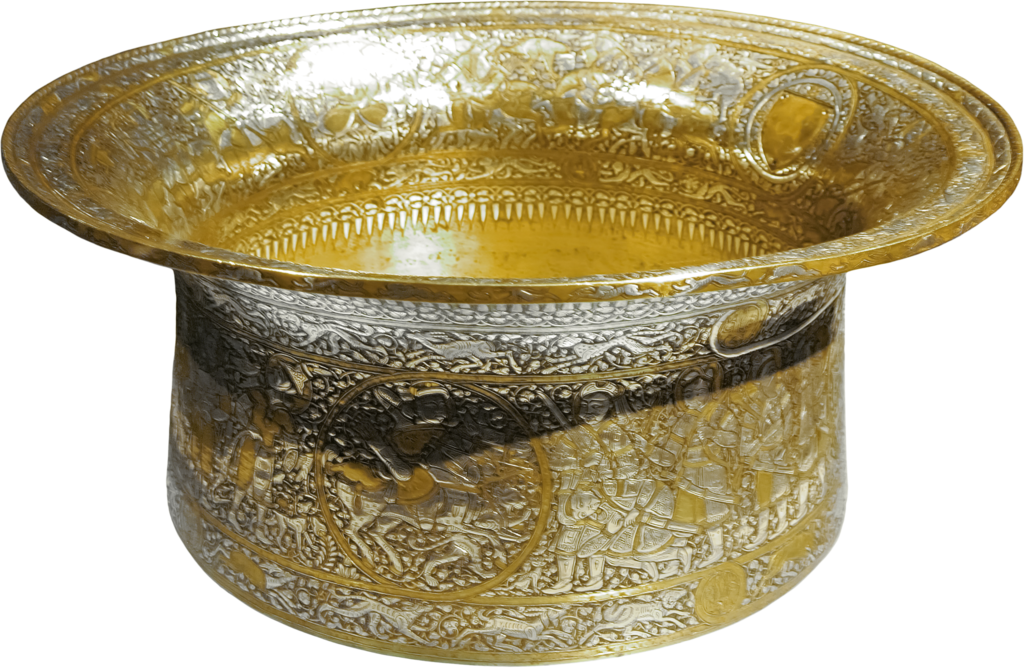
Image Courtesy of Wikipedia (CC BY-SA iii.0)
Image Courtesy of Wikipedia.
Form
-
Brass inlaid with aureate and silverish.
Function
-
Originally, this piece of work was used to wash hands at official ceremonies, simply was subsequently used by the French royal family 🤴 at their baptisms.
Content
-
Pictured on the piece of work is a series of battle scenes betwixt the Mamluks (a group of slave soldiers, many of which converted to Islam) and the Mongols, possibly during the
Mamluk-Ilkhanate Wars.
Context
-
Artists who could inlay (embed pieces of a material into a new textile) were respected because information technology is such a difficult technique to main.
Bahram Gur Fights the Karg
Image Courtesy of OHS APAH.
Form
-
Ink and watercolor.
-
This work looks similar to the illuminated manuscripts (books with text and ornamentation) of unit three, including the Lindisfarne Gospels, Gilded Haggadah, and Bible Moralisée.
Tin you spot any specific similarities between the appearance of Bahram Gur Fights the Karg and the European illuminated manuscripts?
Function
-
The purpose of this work was to tell the story of a fight between Bahram Gur (a king of the Sassanian Empire) and Karg (a unicorn 🦄) using both illustrations and text.
Content
-
Bahram Gur is wearing habiliment made from European fabric, which shows the extent that European and West Asian merchants interacted along the Silk Road. He is too has a halo effectually his head 😇, which shows how exposure to Christianity past Europeans influenced art made in the Islamic world.
-
By choosing to describe this story, the creative person wanted to show how Bahram Gur was an ideal king.
-
The landscape in the scene is inspired by Chinese scroll fine art, showing the syncretism of Chinese and Western farsi styles in this unit of measurement.
Context
-
This work is part of an epic poem called the Shanama (Book of Kings), which recounts the history of ancient Persia.
The Court of Gayumars
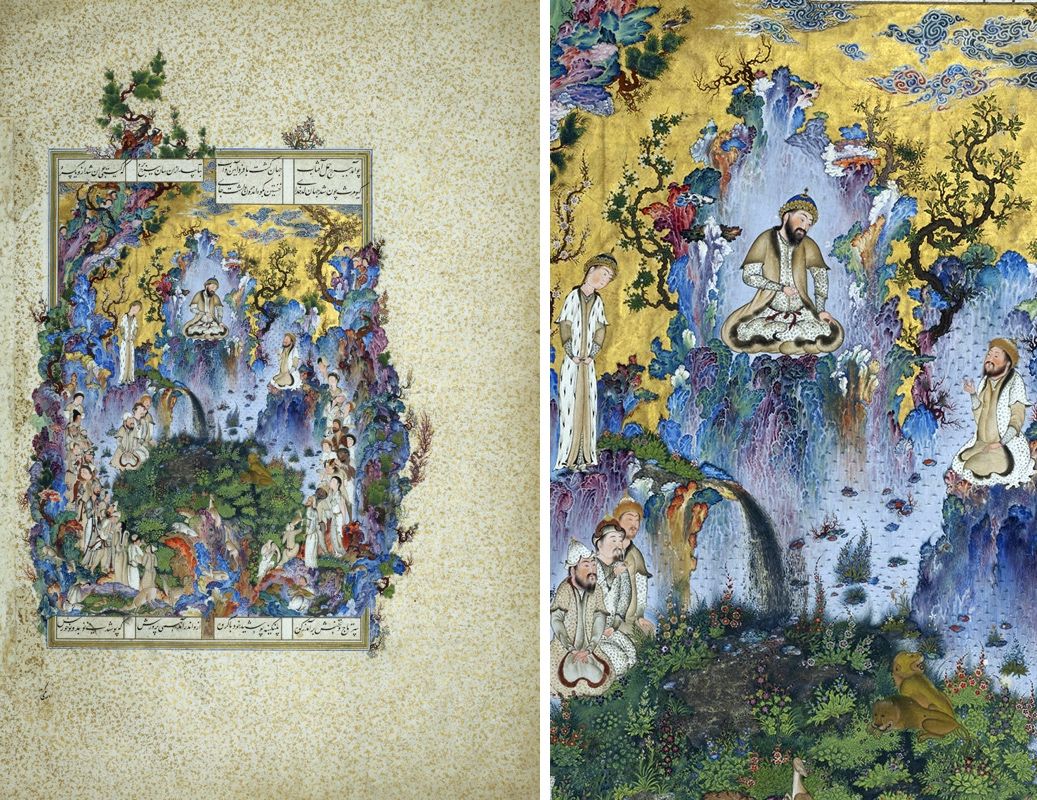
Image Courtesy of Khan Academy
Form
-
Ink, watercolor, and gold on paper.
Function
-
The purpose of this work was to show how humans and landscape tin be harmonious, which is a theme seen throughout Chinese art.
-
Different many of the other works from this region, it did not have a religious purpose, and we know this considering animals and humans are depicted in it.
Content
-
Pictured in the work are Gayumars (the first king of Persia), who is existence enthroned 👑, his son Siyamak, grandson Hushang, and his courtroom, who are sitting below him.
-
The angel pictured in the piece of work is telling Gayumars that the Black Div (son of the demon Ahriman) volition murder his son.
Context
-
Similar to Bahrum Gur Fights the Karg, this work is besides a part of the Shanama.
The Ardabil Carpeting
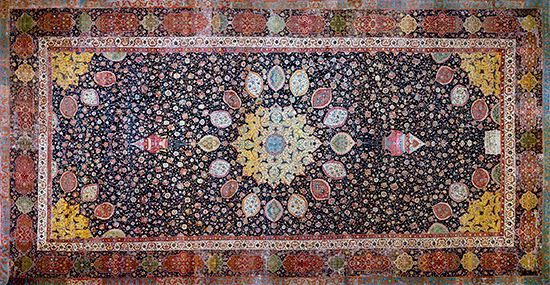
Image Courtesy of Khan Academy.
Form
-
Dyed silk on wood.
Function
-
Carpets similar these were sold along the Silk Road by merchants from the Islamic world. Many of them were then used to decorate buildings like mosques 🕌 and shrines, since they were and so highly valued and prized.
Content
-
At the heart of the Ardabil Carpet is a gold medallion surrounded by sixteen pendants, which may represent the shape of a dome from inside. Two of these pendants also have mosque lamps attached to them.
-
The corners of the inner rectangle look similar squinches (a support that helps attach a round dome to directly walls), which helps complete the feeling of looking 👀 into a dome.
Context
-
The carpet was named for the urban center of Ardabil in nowadays-day Iran, which was a major metropolis 🏙️ of the Safavid Empire. During the time of the Safavids, the arts, particularly textiles, flourished.
Source: https://library.fiveable.me/ap-art-history/unit-7/ap-art-history-unit-7-west-asia/study-guide/eJTwH6bHHWDw1pBlaKFH
0 Response to "Ap Art History Dome of the Rock Form Function Content Context"
Post a Comment